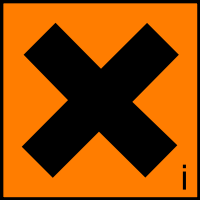NAMES AND DATABASE IDS
NAMES AND DATABASE IDS
Names Database IDs
|
IUPAC name
|
|
2,3-disulfanylpropan-1-ol
|
|
|
|
|
IUPAC Traditional name
|
|
|
Brand Name
|
|
Dimercaprol
|
|
Bal In Oil Injection
|
|
|
|
|
Synonyms
|
|
2,3-Dimercaptopropanol
|
|
British Anti-Lewisite
|
|
BAL
|
|
2,3-Dimercapro
|
|
Dimercaprol
|
|
2,3-DIMERCAPTOPROPANOL
|
|
2,3-Dimercaptopropanol
|
|
Dimercaprol
|
|
Dithioglycerol
|
|
DMP
|
|
2,3-Dimercapto-1-propanol
|
|
2,3-二巯基丙醇
|
|
二巯丙醇
|
|
二硫代甘油
|
|
英国抗路易气剂
|
|
2,3-二巯基-1-丙醇
|
|
|
|
|
CAS Number
|
|
|
EC Number
|
|
|
MDL Number
|
|
|
Beilstein Number
|
|
|
Merck Index
|
|
|
PubChem SID
|
|
|
PubChem CID
|
|
|
ATC CODE
|
|
|
CHEMBL
|
|
|
Chemspider ID
|
|
|
DrugBank ID
|
|
|
KEGG ID
|
|
|
MeSH Name
|
|
|
Unique Ingredient Identifier
|
|
|
Wikipedia Title
|
|
DATA SOURCES
DATA SOURCES
All Sources Commercial Sources Non-commercial Sources
CALCULATED PROPERTIES
CALCULATED PROPERTIES
JChem
ALOGPS 2.1
|
Acid pKa
|
9.578214
|
H Acceptors
|
1
|
H Donor
|
3
|
LogD (pH = 5.5)
|
0.21170121
|
LogD (pH = 7.4)
|
0.20906766
|
Log P
|
0.21173488
|
Molar Refractivity
|
32.9087 cm3
|
Polarizability
|
12.995918 Å3
|
Polar Surface Area
|
20.23 Å2
|
Rotatable Bonds
|
2
|
Lipinski's Rule of Five
|
true
|
|
Log P
|
0.58
|
LOG S
|
-1.65
|
Solubility (Water)
|
2.76e+00 g/l
|
PROPERTIES
PROPERTIES
Physical Property
Safety Information
Product Information
Bioassay(PubChem)
|
Boiling Point
|
|
119.85°C (393K) (at 2.0 kPa)
|
 Show
data source Show
data source
|
|
120 °C/15 mmHg(lit.)
|
 Show
data source Show
data source
|
|
120°C/15mm
|
 Show
data source Show
data source
|
|
|
Flash Point
|
|
>110°C(230°F)
|
 Show
data source Show
data source
|
|
112 °C
|
 Show
data source Show
data source
|
|
233.6 °F
|
 Show
data source Show
data source
|
|
|
Density
|
|
1.239 g cm-3
|
 Show
data source Show
data source
|
|
1.239 g/mL at 25 °C(lit.)
|
 Show
data source Show
data source
|
|
1.244
|
 Show
data source Show
data source
|
|
|
Refractive Index
|
|
1.573
|
 Show
data source Show
data source
|
|
1.5740
|
 Show
data source Show
data source
|
|
n20/D 1.572-1.574
|
 Show
data source Show
data source
|
|
n20/D 1.573(lit.)
|
 Show
data source Show
data source
|
|
n20/D 1.574
|
 Show
data source Show
data source
|
|
|
Partition Coefficient
|
|
0.627
|
 Show
data source Show
data source
|
|
|
pKa
|
|
8.999
|
 Show
data source Show
data source
|
|
|
pKb
|
|
4.998
|
 Show
data source Show
data source
|
|
|
Storage Warning
|
|
Air Sensitive
|
 Show
data source Show
data source
|
|
|
RTECS
|
|
UB2625000
|
 Show
data source Show
data source
|
|
|
European Hazard Symbols
|
|
X
|
 Show
data source Show
data source
|
 Irritant (Xi) Irritant (Xi)
|
 Show
data source Show
data source
|
 Harmful (Xn) Harmful (Xn)
|
 Show
data source Show
data source
|
|
|
UN Number
|
|
2810
|
 Show
data source Show
data source
|
|
UN2810
|
 Show
data source Show
data source
|
|
|
MSDS Link
|
|
|
German water hazard class
|
|
3
|
 Show
data source Show
data source
|
|
|
Hazard Class
|
|
6.1
|
 Show
data source Show
data source
|
|
|
Packing Group
|
|
3
|
 Show
data source Show
data source
|
|
III
|
 Show
data source Show
data source
|
|
|
Risk Statements
|
|
22-36/37/38
|
 Show
data source Show
data source
|
|
22-36/38-43
|
 Show
data source Show
data source
|
|
R:36/37/38
|
 Show
data source Show
data source
|
|
R22, R36/37/38
|
 Show
data source Show
data source
|
|
|
Safety Statements
|
|
24-26-36/37
|
 Show
data source Show
data source
|
|
26-36
|
 Show
data source Show
data source
|
|
S:20-25-26-37/39
|
 Show
data source Show
data source
|
|
S26, S36
|
 Show
data source Show
data source
|
|
|
TSCA Listed
|
|
是
|
 Show
data source Show
data source
|
|
|
GHS Pictograms
|

|
 Show
data source Show
data source
|

|
 Show
data source Show
data source
|

|
 Show
data source Show
data source
|
|
|
GHS Signal Word
|
|
DANGER
|
 Show
data source Show
data source
|
|
Danger
|
 Show
data source Show
data source
|
|
|
NFPA704
|
|
|
 Show
data source Show
data source
|
|
|
GHS Hazard statements
|
|
301, 315, 319, 335
|
 Show
data source Show
data source
|
|
H301-H315-H319-H335
|
 Show
data source Show
data source
|
|
H302-H315-H319-H317
|
 Show
data source Show
data source
|
|
|
GHS Precautionary statements
|
|
261, 301+310, 305+351+338
|
 Show
data source Show
data source
|
|
P261-P280-P305+P351+P338-P302+P352-P321-P501A
|
 Show
data source Show
data source
|
|
P261-P301 + P310-P305 + P351 + P338
|
 Show
data source Show
data source
|
|
|
Personal Protective Equipment
|
|
Eyeshields, Faceshields, full-face respirator (US), Gloves, multi-purpose combination respirator cartridge (US), type ABEK (EN14387) respirator filter
|
 Show
data source Show
data source
|
|
|
RID/ADR
|
|
UN 2810 6.1/PG 3
|
 Show
data source Show
data source
|
|
|
Storage Temperature
|
|
2-8°C
|
 Show
data source Show
data source
|
|
|
Purity
|
|
≥98% (iodometric)
|
 Show
data source Show
data source
|
|
≥98.0%
|
 Show
data source Show
data source
|
|
≥98.0% (GC)
|
 Show
data source Show
data source
|
|
95%
|
 Show
data source Show
data source
|
|
97%
|
 Show
data source Show
data source
|
|
|
Grade
|
|
for complexometry
|
 Show
data source Show
data source
|
|
|
Certificate of Analysis
|
|
|
Quality
|
|
for spectrophotometric det. of Cu
|
 Show
data source Show
data source
|
|
|
Linear Formula
|
|
HOCH2CH(SH)CH2SH
|
 Show
data source Show
data source
|
|
DETAILS
DETAILS
 MP Biomedicals
MP Biomedicals
 DrugBank
DrugBank
 Wikipedia
Wikipedia
 Sigma Aldrich
Sigma Aldrich
DrugBank -
DB06782

|
| Item |
Information |
|
Drug Groups
|
approved |
|
Description
|
Dimercaprol is a traditional chelating agent developed by British biochemists at Oxford University during World War II. It was developed as an experimental antidote against the arsenic-based poison gas Lewisite. It has been used clinically since 1949 in arsenic, cadmium and mercury poisoning. In addition, it has in the past been used for the treatment of Wilson's disease, a genetic disorder in which the body tends to retain copper. Dimercaprol is a potentially toxic drug, and its use may be accompanied by multiple side effects. |
| Indication |
For the treatment of arsenic, gold and mercury poisoning. Indicated in acute lead poisoning when used concomitantly with edetate calcium disodium (DB00974). |
| Pharmacology |
Due to its oily nature, dimercaprol is not absorbed orally and its administration requires deep intra-muscular injection that is extremely painful and allergenic. It was found to mobilize and relocate lead to the brain, increasing its neurotoxic effects. Although treatment with dimercaprol increases the excretion of cadmium, there is a concomitant increase in renal cadmium concentration, so its use should be avoided in cases of cadmium toxicity. |
| Toxicity |
The intramuscular LD50 in rats is approximately 105 mg/kg; intraperitoneally 140 mg/kg. The intraperitoneal LD80 in mice is approximately 125 mg/kg. Dimercaprol has been shown in animal experiments to increase brain deposition of arsenite, organic mercury compounds and increase the toxicity of cadmium and lead. Dimercaprol has been shown to induce seizure in animal studies and also is nephrotoxic. |
| Absorption |
After intra-muscular injection. |
| Half Life |
The drug has a short half life. |
| Elimination |
Urine. |
| References |
| • |
Walshe JM: The conquest of Wilson's disease. Brain. 2009 Aug;132(Pt 8):2289-95. Epub 2009 Jul 13.
[Pubmed]
|
| • |
Boscolo M, Antonucci S, Volpe AR, Carmignani M, Di Gioacchino M: Acute mercury intoxication and use of chelating agents. J Biol Regul Homeost Agents. 2009 Oct-Dec;23(4):217-23.
[Pubmed]
|
| • |
Flora SJ, Pachauri V: Chelation in metal intoxication. Int J Environ Res Public Health. 2010 Jul;7(7):2745-88. Epub 2010 Jun 28.
[Pubmed]
|
| • |
Andersen O: Chemical and biological considerations in the treatment of metal intoxications by chelating agents. Mini Rev Med Chem. 2004 Jan;4(1):11-21.
[Pubmed]
|
|
| External Links |
|
|
Sigma Aldrich -
38520

|
General description
Visit our Titration Center to learn more.
Other Notes
Chelator for heavy metals; used as antidote to heavy metal poisoning (arsenic, gold, mercury, etc)1,2; Reagent for extracting Cu(II)3; Semi-quantitative det. of Cu(II)4 |
PATENTS
PATENTS
 PubChem Patent
PubChem Patent
 Google Patent
Google Patent
